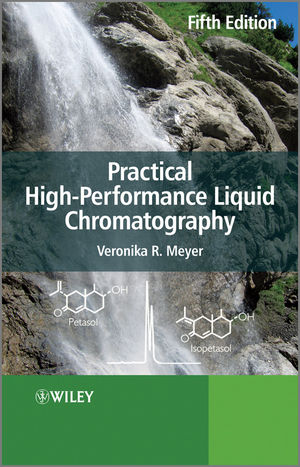Practical High-Performance Liquid Chromatography, 5th EditionISBN: 978-0-470-68218-0
Hardcover
428 pages
May 2010
 This is a Print-on-Demand title. It will be printed specifically to fill your order. Please allow an additional 10-15 days delivery time. The book is not returnable.
Other Available Formats: Paperback
|
||||||
Important and Useful Equations for HPLC.
1 Introduction.
1.1 HPLC: A powerful separation method.
1.2 A first HPLC experiment.
1.3 Liquid chromatographic separation modes.
1.4 The HPLC instrument.
1.5 Safety in the HPLC laboratory.
1.6 Comparison between high-performance liquid chromatography and gas chromatography.
1.7 Comparison between high-performance liquid chromatography and capillary electrophoresis.
1.8 Units for pressure, length and viscosity.
1.9 Scientific journals.
1.10 Recommended books.
2 Theoretical Principles.
2.1 The chromatographic process.
2.2 Band broadening.
2.3 The chromatogram and its purport.
2.4 Graphical representation of peak pairs with different degree of resolution.
2.5 Factors affecting resolution.
2.6 Extra-column volumes (dead volumes).
2.7 Tailing.
2.8 Peak capacity and statistical resolution probability.
2.9 Effects of temperature in HPLC.
2.10 The limits of HPLC.
2.11 How to obtain peak capacity.
3 Pumps.
3.1 General requirements.
3.2 The short-stroke piston pump.
3.3 Maintenance and repair.
3.4 Other pump designs.
4 Preparation of Equipment up to Sample Injection.
4.1 Selection of the mobile phase.
4.2 Preparation of the mobile phase.
4.3 Gradient systems.
4.4 Capillary tubing.
4.5 Fittings.
4.6 Sample injectors.
4.7 Sample solution and sample volume.
5 Solvent Properties.
5.1 Table of organic solvents.
5.2 Solvent selectivity.
5.3 Miscibility.
5.4 Buffers.
5.5 Shelf life of mobile phases.
5.6 The mixing cross.
6 Detectors.
6.1 General.
6.2 UV detectors.
6.3 Refractive index detectors.
6.4 Fluorescence detectors.
6.5 Electrochemical (amperometric) detectors.
6.6 Light-scattering detectors.
6.7 Other detectors.
6.8 Multiple detection.
6.9 Indirect detection.
6.10 Coupling with spectroscopy.
7 Columns and Stationary Phases.
7.1 Columns for HPLC.
7.2 Precolumns.
7.3 General properties of stationary phases.
7.4 Silica.
7.5 Chemically modified silica.
7.6 Styrene-divinylbenzene.
7.7 Some other stationary phases.
7.8 Column care and regeneration.
8 HPLC Column Tests.
8.1 Simple tests for HPLC columns.
8.2 Determination of particle size.
8.3 Determination of breakthrough time.
8.4 The test mixture.
8.5 Dimensionless parameters for HPLC column characterization.
8.6 The van Deemter equation from reduced parameters and its use in column diagnosis.
8.7 van Deemter curves and other coherences.
8.8 Diffusion coefficients.
9 Adsorption Chromatography: Normal-Phase Chromatography.
9.1 What is adsorption?.
9.2 The eluotropic series.
9.3 Selectivity properties of the mobile phase.
9.4 Choice and optimization of the mobile phase.
9.5 Applications.
10 Reversed-Phase Chromatography.
10.1 Principle.
10.2 Mobile phases in reversed-phase chromatography.
10.3 Solvent selectivity and strength.
10.4 Stationary phases.
10.5 Method development in reversed-phase chromatography.
10.6 Applications.
10.7 Hydrophobic interaction chromatography.
11 Chromatography with Chemically Bonded Phases.
11.1 Introduction.
11.2 Properties of some stationary phases.
11.3 Hydrophilic interaction chromatography.
12 Ion-Exchange Chromatography.
12.1 Introduction.
12.2 Principle.
12.3 Properties of ion exchangers.
12.4 Influence of the mobile phase.
12.5 Special possibilities of ion exchange.
12.6 Practical hints.
12.7 Applications.
13 Ion-Pair Chromatography.
13.1 Introduction.
13.2 Ion-pair chromatography in practice.
13.3 Applications.
13.4 Appendix: UV detection using ion-pair reagents.
14 Ion Chromatography.
14.1 Principle.
14.2 Suppression techniques.
14.3 Phase systems.
14.4 Applications.
15 Size-Exclusion Chromatography.
15.1 Principle.
15.2 The calibration chromatogram.
15.3 Molecular mass determination by means of size-exclusion chromatography.
15.4 Coupled size-exclusion columns.
15.5 Phase systems.
15.6 Applications.
16 Affinity Chromatography.
16.1 Principle.
16.2 Affinity chromatography as a special case of HPLC.
16.3 Applications.
17 Choice of Method.
17.1 The various possibilities.
17.2 Method transfer.
18 Solving the Elution Problem.
18.1 The elution problem.
18.2 Solvent gradients.
18.3 Column switching.
18.4 Comprehensive two-dimensional HPLC.
18.5 Optimization of an isocratic chromatogram using four solvents.
18.6 Optimization of the other parameters.
18.7 Mixed stationary phases.
19 Analytical HPLC.
19.1 Qualitative analysis.
19.2 Trace analysis.
19.3 Quantitative analysis.
19.4 Recovery.
19.5 Peak-height and peak-area determination for quantitative analysis.
19.6 Integration errors.
19.7 The detection wavelength.
19.8 Derivatization.
19.9 Unexpected peaks: Ghost and system peaks.
20 Quality Assurance.
20.1 Is it worth the effort?
20.2 Verification with a second method.
20.3 Method validation.
20.4 Standard operating procedures.
20.5 Measurement uncertainty.
20.6 Qualifications, instrument test and system suitability test.
20.7 The quest for quality.
21 Preparative HPLC.
21.1 Problem.
21.2 Preparative HPLC in practice.
21.3 Overloading effects.
21.4 Fraction collection.
21.5 Recycling.
21.6 Displacement chromatography.
22 Separation of Enantiomers.
22.1 Introduction.
22.2 Chiral mobile phases.
22.3 Chiral liquid stationary phases.
22.4 Chiral solid stationary phases.
22.5 Indirect separation of enantiomers.
23 Special Possibilities.
23.1 Micro, capillary and chip HPLC.
23.2 High-speed and super-speed HPLC.
23.3 Fast separations at 1000 bar: UHPLC.
23.4 HPLC with supercritical mobile phases.
23.5 HPLC with superheated water.
23.6 Electrochromatography.
24 Appendix 1: Applied HPLC Theory.
25 Appendix 2: How to Perform the Instrument Test.
25.1 Introduction.
25.2 Test sequence.
25.3 Preparations.
25.4 Pump test.
25.5 UV detector test.
25.6 Autosampler test.
25.7 Column oven test.
25.8 Equations and calculations.
25.9 Documentation.
26 Appendix 3: Troubleshooting.
26.1 Pressure problems.
26.2 Leak in the pump system.
26.3 Deviating retention times.
26.4 Injection problems.
26.5 Baseline problems.
26.6 Peak shape problems.
26.7 Problems with light-scattering detectors.
26.8 Other causes.
26.9 Instrument test.
27 Appendix 4: Column Packing.
Index of Separations.
Subject Index.



